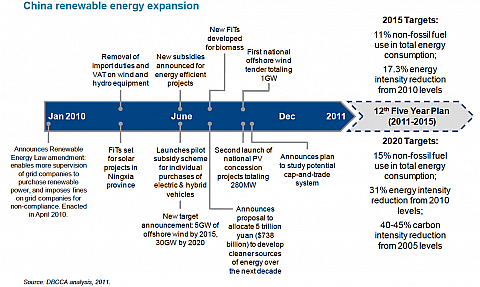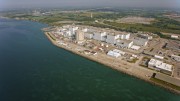The scale of China's climate challenge is massive. But so too is the scale of economic opportunity for China associated with a low-carbon transition. It's increasingly clear that China is taking both quite seriously.
Roughly a year ago, at the World Economic Forum in Davos, Republican Senator Lindsay Graham made a telling admission:
"Six months ago my biggest worry was that an emissions deal would make American business less competitive compared to China. Now my concern is that every day that we delay trying to find a price for carbon is a day that China uses to dominate the green economy."
Sadly, we've seen how recent efforts on pricing carbon in the U.S. worked out. But what about China?
Well, it turns out that Sen. Graham wasn't kidding when told the forum "China has made a long-term strategic decision and they are going gang-busters."
In the year since his comments, an estimated one in twowind turbines installed around the world were installed in China, leading to a 65 per cent growth in wind capacity over 2009 and overtaking the U.S. as world leader in total installed wind capacity. This had been made possible by very strong government support, including national feed-in-tariff programs for wind and biomass with payments totalling CAD$540 million in the second half of 2009 alone. And China has no plans to slow down, with an official target planning for another six-fold increase in installed wind capacity by 2020 and estimates from the Global Wind Energy Council that a ten-fold increase would be feasible in the same period. Meeting the latter target would replace 200 average coal-fired power plants.
The Chinese government has announced that it could invest over CAD$291 billion in wind power alone over the next decade, just under a third of its total clean energy spending. In contrast, Canada's government has effectively ended its support for new renewable power projects. Its successful programs are fully allocated and are set to formally end next month, with no indication that they will be expanded or replaced in the coming federal budget.
China also dominated the world in green stimulus spending, accounting for 39 per cent globally (a greater share of global green stimulus than the U.S. and E.U.'s shares combined) with a stunning US$105 billion of government capital invested in clean technology in 2010. China met its ambitious target of improving the energy intensity of the Chinese economy by 20 per cent in the past five years and has set a goal of cutting its carbon intensity 40-45 per cent by 2020, relative to the 2005 level (along with a set of very ambitious capacity targets for renewable energy).
China takes the lead
Many Chinese cities are beginning to aggressively target low-carbon industries to establish themselves as green technology manufacturing hubs, recognizing the rising demand that exists globally, but also within China itself.
 Consider solar water heaters. China is already both the world's leading producer and consumer of these devices. In 2009, China accounted for 50 per cent of the world's production of solar water heaters, and 65 per cent of all installations. Dezhou, a municipality of 5 million people that calls itself "China's Solar Energy City," now boasts solar water heaters on 90 per cent of its residential buildings, along with a host of other solar-powered industrial developments.
Consider solar water heaters. China is already both the world's leading producer and consumer of these devices. In 2009, China accounted for 50 per cent of the world's production of solar water heaters, and 65 per cent of all installations. Dezhou, a municipality of 5 million people that calls itself "China's Solar Energy City," now boasts solar water heaters on 90 per cent of its residential buildings, along with a host of other solar-powered industrial developments.
China is investing heavily in electric vehicles (as well as public transportation), in recognition of the booming demand for cars from China's growing middle class. The federal government, which already offers generous incentives for the purchase of low-carbon vehicles (as do many Chinese cities), is expected to invest CAD$14 billion in the green auto industry over the next decade and make it a core focus of its next five-year plan. Officials are anticipating production of electric vehicles could reach one million by 2020, and are planning to install 10 million charging stations by that date.
China leads the world with 7,431 kilometres of high-speed railways already in operation — a network they are planning to expand to 13,000 kilometres by 2012.
In short, China is increasingly becoming a global leader in green industry. According to Ernst & Young's November 2010 renewable energy country attractiveness index, "a new world order is emerging in the clean energy sector with China now the clear leader in the global renewables market." Canada placed 9th in the overall ranking for attractiveness to renewables investment.
All of this is good news, and adds an exciting spark to the global race for clean and affordable energy. But, given the epic scale of China's emissions, is it enough?
Innovation and emissions in context
China has an enormous population and its economy is growing at a frenetic pace. It has already surpassed the U.S. as the world's top emitter of greenhouse gases and, unless significant new policies are put in place, China is expected to significantly boost its emissions as it continues to grow — due in large part to its heavy reliance on coal power, which currently accounts for 80 per cent of electricity generation. In light of China's total greenhouse gas pollution, are the advances mentioned above really more than a drop in the bucket?
If China did nothing to reduce its emissions intensity, by 2030 it would be consuming the entire world's annual carbon budget for a 2˚C-compatible emissions path. To frame the size of the challenge, consider this: According to calculations by Lord Nicholas Stern, a former chief economist of the World Bank, China's emissions could nearly quadruple by 2030, assuming that China's economy grows at its anticipated rate of 7 per cent per year and maintains its current carbon intensity. By 2030, China would be consuming the entire world's annual carbon budget for a 2˚C-compatible emissions path.
While more ambition is needed, China's current goals to slash carbon emissions per unit of GDP and boost its use of low-carbon energy sources would remove a huge chunk of those projected emissions, possibly up to 21 billion tonnes of greenhouse gases, creating an a reduction of up to 60 per cent from the business-as-usual scenario outlined above in the next 20 years. (By way of comparison, Alberta's Climate Change Strategy is targeting a less ambitious emissions reduction of 50 per cent below business-as-usual by 2050).
If China can further boost its level of ambition to the point where emissions return to current levels by 2030, Stern estimates they will be pulling their (considerable) weight in the global effort to keep global warming below the critical 2˚C threshold.
"If it's two steps forward in Canada but eight steps back in China, that doesn't deliver the goods in the fight against climate change, that doesn't deliver the goods for the environment, it doesn't deliver the goods for the world."
— Then-environment minister John Baird at the UN climate negotiations in Cancun
While the challenge is massive, China's leadership appears to be increasingly aware of both its central role in tackling climate change and the enormous opportunities in doing so. There are many indications that transitioning towards low-carbon development will be at the heart of its next five-year plan, due in March.
It's clear that all countries — including China — need to do more to tackle climate change. The scale of reductions urgently needed is vast and will require nothing less than a complete transformation of the global energy system. But with China's interest in playing a leading role in this new industrial revolution seemingly growing by the day, it's just not accurate for Canada's government to point to China as an excuse for our own inaction.
It's time for all of us to get to work.
Editor's note: In our next post we will explore the many drivers pushing climate action to the fore in China, and look ahead to what analysts expect in its next five-year plan.
Some excellent resources for better understanding China's current climate and energy policies can be found at the World Resources Institute's ChinaFAQs network.










